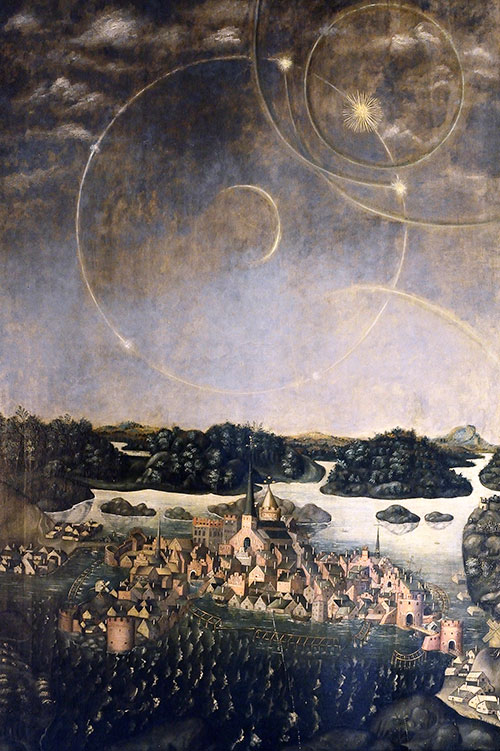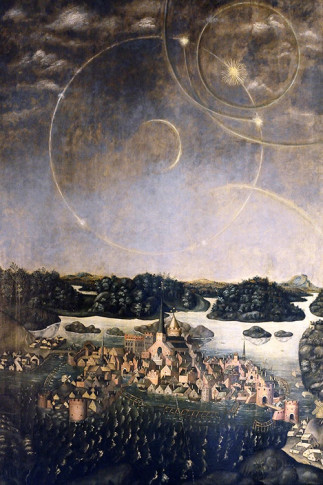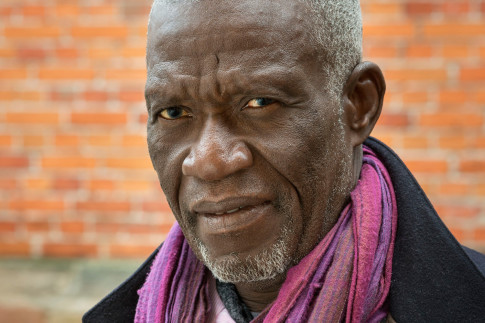
The Sun Dog Painting, early 16th century
Stockholm Cathedral. Photo: Magnus Aronson
The Birth of Stockholm…!
In the 16th century halo phenomena were seen as ominous signs. It is believed that Olaus Petri, a preacher at Stockholm cathedral and a major theologian of the time, commissioned the painting following the confiscation of the church’s treasures by the king Gustav Vasa. Olaus Petri used the painting in his sermons to illustrate the dire consequences of the king’s disrespect for the independence of the church. The king in turn was insulted by Petri’s provocative use of the halo rings against him.
“The stars influence life but do not determine it – man is the architect and free arbitrator of his own destiny.” Georges Adéagbo
Characteristic of his working method Adéagbo later “translated” the Sun Dog Painting by ordering a wood relief based on the painting, from an artisan in his hometown Cotonou. The paintings in Adéagbo’s installations are never carried out by him but are commissioned and produced by Cotonou artisans according to his instructions. The wood relief after the Storkyrkan painting is part of the new installation, La naissance de Stockholm…!/ The birth of Stockholm…!, for Moderna Museet.
A central aspect of Adéagbo’s method is to investigate how objects and events are construed and charged with meaning, depending on different on-lookers’ cultural context. By exploring the city, its culture and history – such as the local flea markets and in Stockholm’s case a 17th century painting of the castle Tre Kronor and David Beck’s Queen Christina portrait of the same period – he composes the installation into a complex collage. Books, newspapers and clothes acquired in various cities are combined with illustrations and carvings interwoven with handwritten texts. A romcom dvd and a self-help book are placed next to a carved wooden figure. Through chains of associations and cultural transfer like this, Adéagbo constantly constructs new narratives.
In The Birth of Stockholm…! Adéagbo also examines the history of the Moderna Museet and its collections. Artworks of iconic status, that are part of the Western modernist art canon, are rendered in new versions. The goat adorned with rubber tire in Robert Rauschenberg’s famous combine Monogram (1955–59) is re-interpreted into Abraham’s biblical sacrifice when juxtaposed with text from the Old Testament. In several parts of the exhibition archive photos of pivotal moments in the museum’s history are transformed into paintings. For example, a photo from 1967 of former museum director Pontus Hultén and the artist Lucio Fontana has been reproduced as a black and white painting.
By creating these networks of objects and texts, Adéagbo pays attention to the relationship of oral and written transmissions of knowledge and history.
His linking of text and objects together comments on what these media represent in different societies. We ascribe stories to things. Objects contain a multitude of references and in this way function similarly to how the written word may operate. Adéagbo’s texts introduce general themes in his work as well as specific questions and propositions relevant to the installation’s specific location. He covers subjects such as religion, philosophy, historical events, politics and his own personal history. But the circumstances, encounters and friendships that brought him to a certain city and institution enter the work as well. Names of curators, critics, and friends may appear and the usually hidden process of creating an exhibition can become the subject of written reflections.
This poetic writing is complementary to the stories created through the selection and combinations of objects. The past and the present, high and low, local and distant, coexist in the installations that also embody Georges Adéagbo’s philosophy of the relationship between free will and destiny


